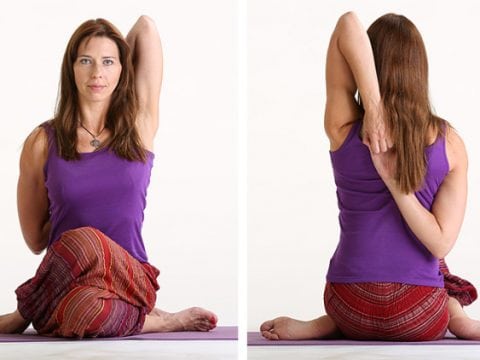Gomukhasana (Cow Face Pose): How to Perform, Benefits, & Precautions

Yoga is an ancient spiritual practice that helps to bring balance and harmony between the mind and body. Although yoga originated in India, it has been gaining popularity quickly all over the world. There are many different yoga poses, but in this article we will focus on the Gomukhasana yoga pose and its benefits in detail. ‘Go’ in Sanskrit means cow, ‘mukha’ means face, and ‘asana’ means pose.
The ‘Gomukh’ yoga pose gets its name from the lightheaded feeling one gets when performing the pose, which also happens to resemble a cow’s face.
What is Gomukhasana (Cow face pose)?
The Sanskrit word Gomukhasana translates to “cow face pose yoga.” Asana means posture, and this particular asana can be performed with a set of different asanas. It is a seated yoga posture that enhances your chest, shoulders, arms, and triceps. The name “cow-face” is given to this yoga asana because your body looks like a cow’s face while performing this asana.
Step by Step Procedure to Perform Gomukhasana:
Here is the simple procedure of the Gomukhasanayoga pose you need to follow to get all the benefits associated with it.
- Sit down on a yoga mat on the floor.
- Stretch your legs in front while keeping your back erect.
- Now place your left leg under your right buttock gently.
- Place your right leg over your left thigh by folding it.
- Make sure your knees are stacked on top of the other and close together.
- Place your left arm behind your back by folding it.
- Now stretch your right arm to reach your left hand by placing the right arm over your right shoulder. Stretch as much as you can.
- It might not feel easy initially, but you can stretch your hands behind your back with practice.
- Expand your chest, lean slightly back while keeping your trunk erect.
- Make sure you remain in this pose for as long as you can.
- Concentrate on your breathing throughout performing this asana.
Preparatory Poses for Gomukhasana:
Below are some Gomukhasana preparatory poses to help you ease into the position. Remember to practice these poses slowly and with control to avoid injury:
- Suptavirasana
- Baddhakonasana
- Suptapadangusthasana
- Suptabaddhakonasana
- Virasana
- Upavisthakonasana
Follow-up poses for Gomukhasana:
Here are some of the yoga asanas you can try after practicing the cow face pose or Gomukhasana:
- Bharadvajasana
- ArdhaMatsyendrasana
- Padmasana
- Garudasana
- UpavisthaKonasana
- Paschimottanasana
- Marichyasana III
Gomukhasana Health Benefits:
Here are some of the yoga asanas you can try after practicing the cow face pose or Gomukhasana:
- Bharadvajasana
- ArdhaMatsyendrasana
- Padmasana
- Garudasana
- UpavisthaKonasana
- Paschimottanasana
- Marichyasana III
Contraindication And Precautions of Gomukhasana:
Gomukhasana precautions and contraindications:
-If you have rotator cuff injuries or knee pains, or are experiencing excessive shoulder pain, refrain from practicing Gomukhasana.
- -If you have backache, practice this asana under the guidance of a certified yoga instructor.
- -If you feel pain in any body part during the stretching part of the Gomukhasana, do not do the asana.
- -If you have soft tissue injuries such as muscle damage, ligaments, or tendons, refrain from performing this asana.
Cow face poses with eagle arms:
The Gomukhasana yoga pose is highly beneficial and relatively easy to perform. Even simple stretches can have a significant impact on your overall health. Take a look at the process mentioned in this article. If you’re a beginner, it’s always best to seek professional help to avoid any accidents. And if you found this article helpful, be sure to let us know!
The information in this article is for general information purposes only and does not constitute professional advice. You should always consult a professional before trying anything new. The website cannot guarantee the accuracy or authenticity of the information.
FAQ:
Can an obese person practice yoga?
Please note that the information provided in this article is for research purposes only and should not be taken as professional advice. Always consult a qualified professional before trying any new methods or approaches. The website cannot be held responsible for the accuracy of the information provided.
Is it ok to eat food before practicing yoga?
It is always advised to perform yoga on an empty stomach or eat food one hour before practicing yoga asanas. This is because it is suggested that your bowels should be empty while you practice yoga in order to avoid any accidents or discomfort.
-
How regularly should we perform yoga?
According to yoga experts, performing yoga two to five times a week is ideal for seeing efficient results. However, it’s necessary to ease into the asanas (yoga poses) gradually, letting your body get used to them before making it a more regular habit.